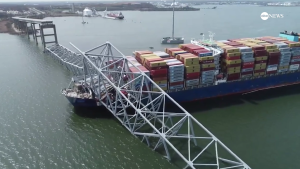The coexistence of maritime and terrestrial traffic can occasionally result in catastrophic encounters, particularly when massive vessels come into contact with the towering structures of bridges. These incidents not only underscore the importance of navigational precision but also highlight the potential for immense structural and environmental damage. Here, we explore five significant ship-bridge accidents from around the globe, including the recent incident in Baltimore, that have left indelible marks on maritime history.
1. The Baltimore Incident: A Wake-Up Call for Maritime Safety
In a recent event that gripped the city of Baltimore, a large vessel collided with a key bridge, causing immediate concerns over structural integrity and traffic flow disruptions. The accident brought to light the challenges of navigating large ships in proximity to urban infrastructure and sparked a comprehensive review of safety protocols and bridge design standards. This incident not only affected the local community and economy but also served as a stark reminder of the delicate balance between maritime and urban environments.

2. The Sunshine Skyway Bridge Disaster, USA, 1980
On May 9, 1980, the freighter SS Summit Venture collided with the Sunshine Skyway Bridge in Tampa Bay, Florida, amidst a severe thunderstorm. The accident led to the collapse of a portion of the bridge, resulting in 35 fatalities as vehicles plunged into the waters below. This tragic event prompted significant enhancements in storm preparedness, bridge design, and navigational aids, including radar reflectors and improved bridge lighting, to prevent similar catastrophes.
3. The Queen Juliana Bridge Accident, Curaçao, 1964
The Queen Juliana Bridge in Curaçao witnessed a catastrophic accident when the freighter MS Oranjestad struck it during construction in 1964. The collision caused significant delays to the bridge’s completion and emphasized the need for stringent safety measures during both the construction and operational phases of bridge management. It also led to a reevaluation of maritime routes and bridge protection systems in the region.
4. The Big Bayou Canot Rail Accident, USA, 1993
Although primarily a train disaster, the Big Bayou Canot rail accident was caused by a barge striking a railroad bridge in Alabama. The collision dislodged the bridge, and moments later, a train derailed and crashed, resulting in 47 deaths. This incident highlighted the broader implications of ship-bridge collisions, leading to improved communication and tracking systems for vessels navigating near bridges.
5. The Kerch Strait Bridge Incident, Crimea, 2018
The Kerch Strait Bridge, a vital link between Crimea and the Russian mainland, was struck by a large ship in 2018, causing substantial damage. The incident underscored the geopolitical tensions in the region and the importance of maintaining critical infrastructure. It prompted a reevaluation of maritime traffic regulations and the implementation of stricter controls to safeguard this essential bridge.
Navigational Challenges and Future Safeguards
These incidents collectively illustrate the complexities and dangers associated with the intersection of maritime and terrestrial traffic. They highlight the need for continuous advancements in navigation technology, bridge design, and regulatory frameworks to mitigate the risks of future collisions. As we move forward, the lessons learned from these tragedies will undoubtedly play a crucial role in shaping a safer and more resilient infrastructure for both ships and bridges alike.


I like this article, piease update it.